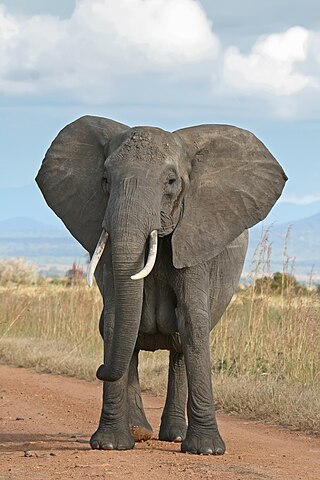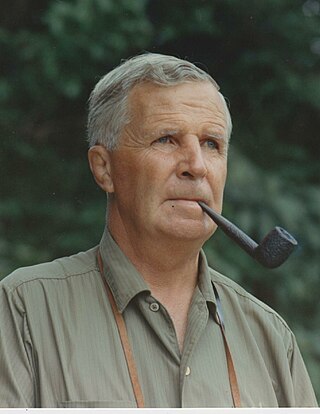Related Research Articles
Amboseli National Park, formerly Maasai Amboseli Game Reserve, is a national park in Loitoktok District in Kajiado County, Kenya. It is 39,206 ha (392.06 km2) in size at the core of an 8,000 km2 (3,100 sq mi) ecosystem that spreads across the Kenya-Tanzania border. The local people are mainly Maasai, but people from other parts of the country have settled there attracted by the successful tourist-driven economy and intensive agriculture along the system of swamps that makes this low-rainfall area, average 350 mm (14 in), one of the best wildlife-viewing experiences in the world with 400 species of birds including water birds like pelicans, kingfishers, crakes, hamerkop and 47 raptor species.
The Born Free Foundation is an international wildlife charity that campaigns to "Keep Wildlife in the Wild". It protects wild animals in their natural habitat, campaigns against the keeping of wild animals in captivity and rescues wild animals in need. It also promotes compassionate conservation, which takes into account the welfare of individual animals in conservation initiatives. Born Free also creates and provides educational materials and activities that reflect the charity's values.
Saba Iassa Douglas-Hamilton is a Kenyan wildlife conservationist and television presenter. She has worked for a variety of conservation charities, and has appeared in wildlife documentaries produced by the BBC and other broadcasters. She is currently the manager of Elephant Watch Camp in Kenya’s Samburu National Reserve and Special Projects Director for the charity Save the Elephants.
Dame Daphne Marjorie Sheldrick, was a Kenyan of British descent, author, conservationistand expert in animal husbandry, particularly the raising and reintegrating of orphaned elephants into the wild for over 30 years. She was the founder of the Sheldrick Wildlife Trust.

Elephant cognition is animal cognition as present in Elephant elephants. Most contemporary ethology ethologists view the elephant as one of the world's most intelligent animals. With a mass of just over 5 kg (11 lb), an elephant's brain has more mass than that of any other land animal, and although the largest whales have body masses twenty times those of a typical elephant, a whale's brain is barely twice the mass of an elephant's brain. In addition, elephants have around 257 billion neurons. Elephant brains are similar to those of humans and many other mammals in terms of general connectivity and functional areas, with several unique structural differences. Although initially estimated to have as many neurons as a human brain, the elephant's brain has about three times the amount of neurons as a human brain. However, the elephant's cerebral cortex has about one-third of the number of neurons as a human's cerebral cortex.

Dr. Iain Douglas-HamiltonCBE is a Scottish zoologist from Oxford University and one of the world's foremost authorities on the African elephant. Douglas-Hamilton pioneered the first in-depth scientific study of elephant social behaviour in Tanzania's Lake Manyara National Park, aged 23. His work in the 1960s paved the way for much of today’s understanding of elephants and current conservation practices. During the 1970s he investigated the status of elephants throughout Africa and was the first to alert the world to the ivory poaching holocaust, bringing about the first global ivory trade ban in 1989. In 1993, Douglas-Hamilton founded Save the Elephants, which is dedicated to securing a future for elephants and their habitats. For his work on elephants he was awarded two of conservation's highest awards - the Order of the Golden Ark in 1988, the Order of the British Empire in 1992, and the Commander of the British Empire (CBE) in 2015. In 2010, he was named the recipient of the Indianapolis Prize, the world's leading award for animal conservation. In May 2012, Douglas-Hamilton spoke at the Senate Foreign Relations Committee hearing on Ivory and Insecurity: The Global Implications of Poaching in Africa.

The African bush elephant, also known as the African savanna elephant, is one of two extant African elephant species and one of three extant elephant species. It is the largest living terrestrial animal, with bulls reaching an average shoulder height of 3.04–3.36 metres (10.0–11.0 ft) and a body mass of 5.2–6.9 tonnes (11,500–15,200 lb), with the largest recorded specimen having a shoulder height of 3.96 metres (13.0 ft) and a body mass of 10.4 tonnes (22,900 lb).
The African Wildlife Foundation (AWF) is an international conservation organization created with the aim of preserving Africa's wildlife, wild lands, and natural resources.
Helen Wanjiru Gichohi is a Kenyan ecologist who was President of the African Wildlife Foundation (AWF) from 2007 to 2013.

The Sheldrick Wildlife Trust (SWT) operates an orphan elephant rescue and wildlife rehabilitation program in Kenya. It was founded in 1977 by Dame Daphne Sheldrick to honor her late husband, David Sheldrick. Since 2001, it has been run by their daughter, Angela Sheldrick.
Echo was an African bush elephant matriarch who was studied for over 30 years by ethologist Cynthia Moss, beginning in 1973, and was the subject of several books and films. She was the first subject of the Amboseli Elephant Research Project, the longest-running study of a land mammal. The study of Echo and her family contributed significantly to the understanding of elephants, including their life-cycles, methods of communication, emotional lives, and cooperative care of the young.
The Amboseli Elephant Research Project is a long-term research project on the ethology of the African elephant, operated by the nonprofit Amboseli Trust for Elephants. The project studies the elephant's social behavior, age structure and population dynamics. It is the longest running study of elephant behavior in the wild, and has gathered data on life histories and association patterns for more than 2,000 individual elephants.
Jim Justus Nyamu, of Nairobi, Kenya, is an elephant research scientist and activist against poaching and trade in ivory. Nyamu is the executive director at the Elephant Neighbors Center (ENC) and is leader of the movement, Ivory Belongs to Elephants. He has also held positions at the African Conservation Centre and Kenya Wildlife Service. The ENC is a grass-roots collaborative and participatory research organization focused on enhancing the capacity of communities living with wildlife to promote interlinkages between species and their habitats.
The Tsavo Conservation Area is a complex of protected and other wildlife areas in southern Kenya and north-eastern Tanzania. It is composed of Tsavo East National Park, Tsavo West National Park, Chyulu Hills National Park, South Kitui National Reserve, ranches in Galana, Taita, Kulalu and Amboseli and adjacent private and communal lands. Bordering Mkomazi National Park in Tanzania, the Tsavo Conservation Area comprises an area of around 42,000 km2, of which over 25,000 km2 is protected. The protected portion in Kenya represent almost half of the country's protected areas.
Joyce Hatheway Poole is a biologist, ethologist, conservationist, and co-founder/scientific director of ElephantVoices. She is a world authority on elephant reproductive, communicative, and cognitive behavior.

John Simpson Owen was a Ugandan-born British conservationist who served as Director of the Tanzania National Parks from 1960 to 1972, during which time he was responsible for the establishment and management a network of National Parks, the Promotion of Scientific Research as a basis for conservation and wildlife tourism in the Serengeti National Park. He was awarded the World Wildlife Fund Gold Medal in 1973 for this and its contribution to the economy of a developing country. He was also the recipient of the Order of the Golden Arc from Prince Bernhard of the Netherlands.
The Big Life Foundation is a non-profit conservation organization created to preserve the wildlife and habitats of the Amboseli-Tsavo-Kilimanjaro ecosystem of East Africa through community-based and collaborative strategies.
Resson Kantai Duff is Kenyan conservationist and the deputy director at Ewaso Lions.

Winnie Kiiru is a Kenyan biologist, elephant conservationist, and the chairperson of the Wildlife Research Institute in Naivasha. She is currently the chairperson of Friends of Karura Forest, a Community-Based Organization (CBO) that helps manage Karura forests.
References
- 1 2 3 4 5 6 7 8 9 10 11 12 13 14 Pringle, Laurence (November 1, 1997). Elephant Woman. Atheneum. ISBN 9780689801426.
- 1 2 3 "Dr. Cynthia Moss". Amboseli Trust for Elephants. Retrieved 10 September 2017.
- 1 2 3 Yount, Lisa (1999). A Biographical Dictionary A to Z of Women in Science and Math. New York: Facts on File, Inc. pp. 156–158. ISBN 0816037973.
- ↑ Buzzeo, Toni (September 29, 2015). A Passion for Elephants: The Real Life Adventure of Field Scientist Cynthia Moss. Dial Books. ISBN 9780399187254.
- 1 2 Robinson, Simon. "Free As The Wind Blows". Time. Time Inc. Retrieved 3 December 2017.
- ↑ Murphy, Kate (30 May 2015). "Cynthia Moss". The New York Times. Retrieved 20 November 2017.
- 1 2 Moss, Cynthia (February 12, 1976). Portraits in the Wild: Animal Behaviour in East Africa. Hamish Hamilton Ltd. p. 363. ISBN 9780241024539.
- ↑ Moss, Cynthia. "Note from the Director". Amboseli Trust for Elephants. Retrieved 10 September 2017.
- ↑ Moss, Cynthia (1988). Elephant Memories: Thirteen Years in the Life of an Elephant Family. Chicago: University of Chicago Press. ISBN 9780226148533.
- ↑ "African Elephants". www.fws.gov. Retrieved 2017-12-03.
- ↑ Moss, Cynthia. "Amboseli & Us". Amboseli Trust for Elephants. Retrieved 10 September 2017.
- ↑ Moss, Cynthia (1993). Echo of the Elephants: The Story of an Elephant Family. William Morrow & Co. ISBN 9780688121037.
- ↑ Moss, Cynthia (2011). The Amboseli Elephants: A Long-Term Perspective on a Long-Lived Mammal. Chicago: University of Chicago Press. ISBN 9780226542232.
- ↑ "Cynthia Moss Wins 2001 MacArthur Fellowship". African Wildlife Foundation. 2001-10-24. Retrieved 2017-12-03.